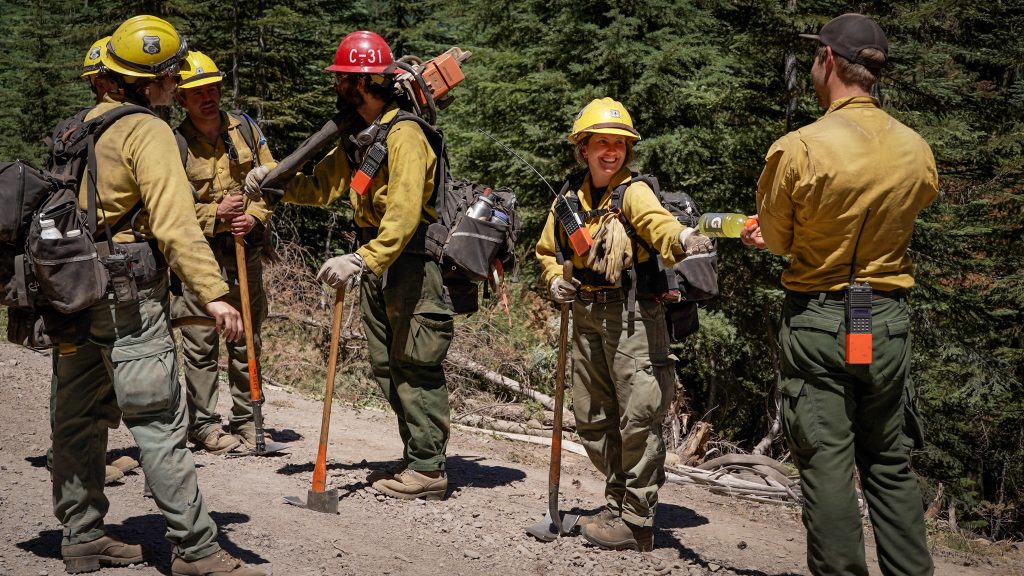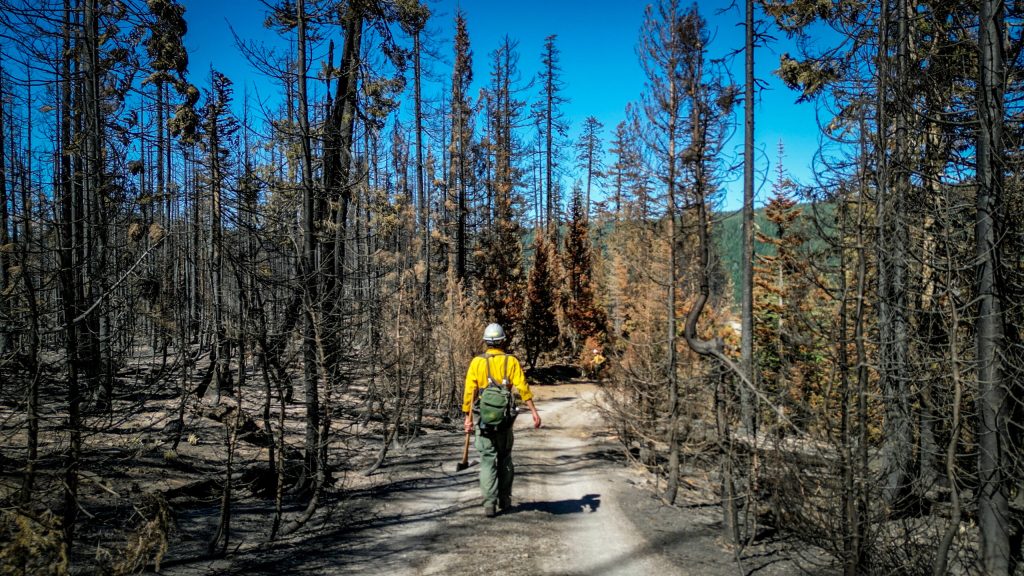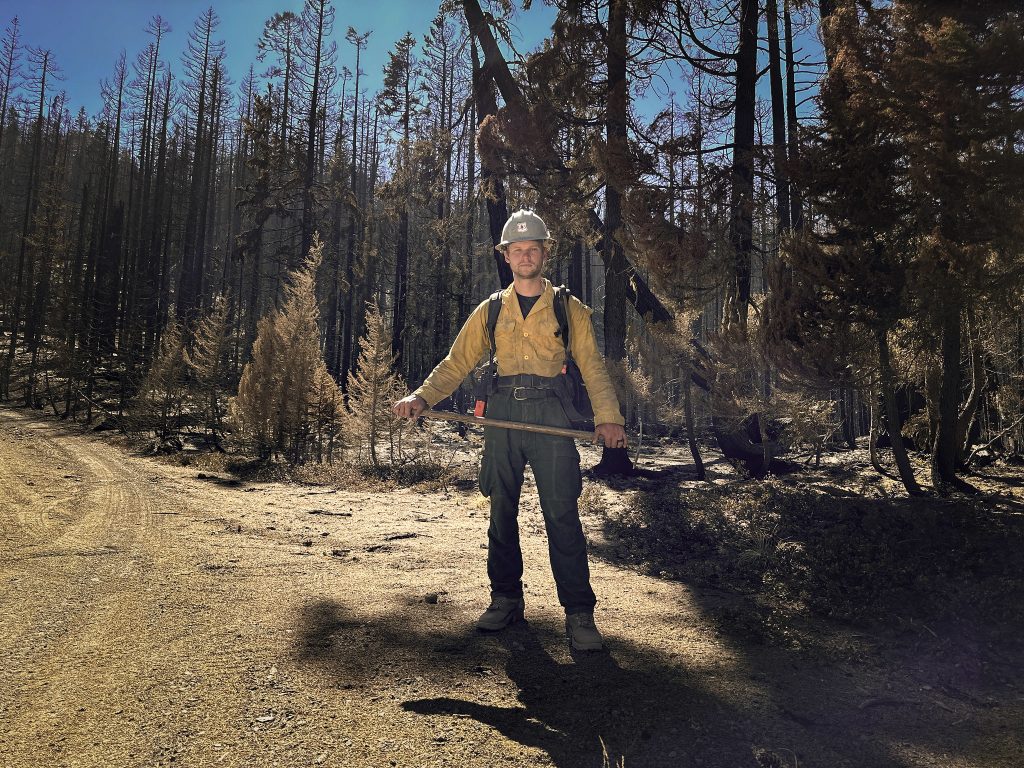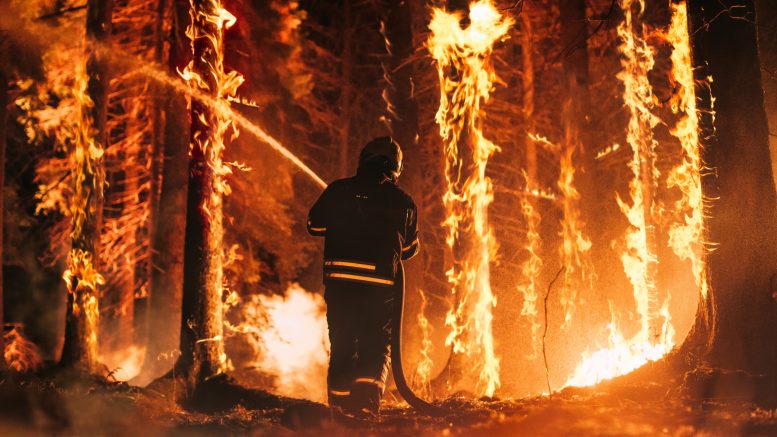Firefighters credit a perfect storm of more fires, low wages and dangerously high turnover rates for the trend.
By Nathan Pipenberg, Capital & Main
This story is produced by the award-winning journalism nonprofit Capital & Main and co-published here with permission.
After wildland firefighter Ben McLane fought California’s deadliest fire, he started second-guessing his line of work. The November 2018 Camp Fire near Paradise had killed 85 and leveled 18,000 homes. McLane was used to hiking steep terrain and digging endless fire breaks. He was accustomed to the spectacle of entire hillsides of pine and fir aflame. He wasn’t used to this scale of devastation — or feeling he’d worked in vain. Meanwhile, he rarely saw his family, and couldn’t fathom affording a house. Was firefighting worth it?
McLane was still second-guessing when he heard about Grassroots Wildland Firefighters, a nonprofit organization for federal firefighters founded in 2019 by former firefighters Luke Mayfield and Kelly Martin. Climate change had extended fire seasons by as much as eight weeks, while development pressures mean more people live in fire zones. Starting wages were around $27,000 a year. The resulting turnover made the job even more dangerous for whomever was left. Even with more than half of federal firefighters unionized, change felt far off.
“In our business, we look for the right tool for the right job,” said McLane, who stuck with the job, and began speaking publicly about his experiences as a federal firefighter in 2021. “[The union] is not the right tool to be the authentic voice of wildland firefighters, because they represent all federal employees. So it really wasn’t a matter of if but when a group like Grassroots would come along.”
Today, Grassroots Wildland Firefighters represents a striking example of a growing movement among workers to organize outside the structure of an existing union. Some workers, like those at Amazon and Trader Joe’s, choose to start their own union without immediately affiliating with an existing one. Others, often those in decentralized “gig work” or immigrants fearful of deportation, form workers’ centers.
Federal wilderness firefighters fall into another category. There are currently about 19,000 employed by the federal government, with about 10,000 in a single union, the National Federation of Federal Employees. (The other 9,000 federal workers, as well as wilderness firefighters employed by states, conservation groups and private firms, are split among other unions or are nonunion.) But as with wages for most other federal employees, hikes beyond incremental annual increases have to be approved by legislation or executive order — which take political power, often drawn from public attention.
With National Federation of Federal Employees members spread across government offices from the Department of Defense to the Passport Service, firefighters increasingly felt they needed to make themselves heard if they wanted to see change. So far, Grassroots Wildland Firefighters — working alongside NFFE — has proven that point.
“Grassroots is really good at getting the message out to the general public,” said Max Alonzo, a former firefighter hired by NFFE in 2020 to assist local land management union chapters with everything from communications to legislative plans (and just named national secretary-treasurer of the union). “I don’t feel like we’d be as far as we are right now if they hadn’t brought national attention to these issues.”
Case in point: When Congress began considering a pay supplement for federal firefighters, whose starting wage is the federal worker minimum of $15 an hour, both the union and Grassroots Wildland Firefighters organized front-line workers to meet with members of Congress and speak at committee hearings and a press conference on the steps of the Capitol. Grassroots volunteers spoke about how they’ve become the “forgotten first responders” who have been forced to “live out of their vehicles just to get by,” as well as their increased risk of lung cancer, cardiovascular disease and mental health problems.
That’s something that Luke Mayfield, president of Grassroots Wildland Firefighters, knows well. After 18 years in the field, he was battling pre- and post-season depression, anxiety attacks and, eventually, suicidal ideation. “It felt like the crew was going to be my priority for the next six months, while my wife and daughter took a back seat,” he said.

In early 2019, he left the job. He helped found Grassroots Wildland Firefighters later that year.
Grassroots also encourages firefighters to speak out publicly, putting workers in touch with media outlets and creating guidelines for how and why to speak to journalists. Petitions and letter-writing campaigns are another big focus: a “Contact Your Reps” campaign urging passage of the Wildland Firefighter Paycheck Protection Act garnered more than 12,000 letters.
With pressure came promising results: temporary pay supplements, expiring this September, that currently translate to as much as $20,000 per year. Although it was not the permanent legislation they sought, firefighters saw their starting annual income nearly double, to $51,500.
The increase would have been far harder to achieve if firefighters had relied on the union alone, says Kelly Andersson, the editor of Wildfire Today, who’s covered the industry for more than two decades. “The effective driving force behind awareness of the firefighter pay issues and progress toward a solution is undoubtedly the people with Grassroots Wildland Firefighters,” she said. “They have consistently kept these issues in front of firefighters, their supporters and the public.”
* * *
For all the attention paid to wildfires, there’s little public discussion of the working conditions for the firefighters who put them out. It’s a troubling omission, said Riva Duncan, vice president of Grassroots Wildland Firefighters and a 31-year veteran of Forest Service firefighting squads. “Nobody understood my job,” she said. “My family still to this day doesn’t really know what I did for a living. But we believe that you can’t talk about a wildfire crisis without talking about the firefighters.”
The job can be grueling and unusually demanding. Wildland workers are expected to serve as a “national resource,” available to travel across the country with only a few hours’ notice. On an active fire, assignments last two weeks, with no days off, and shifts run from 6 a.m. to 10 p.m. Firefighters fell trees, dig fire breaks and crawl on hands and knees to find hotspots that could ignite. They often sleep outdoors, near the fire and in the smoke.
While crew leaders are typically salaried and full time, rank-and-file firefighters are usually seasonal workers who make up about half the workforce. They typically work six months of the year, logging 800 to 1,200 hours of overtime each fire season — the equivalent of five to seven-and-a-half months of full-time work. After the season, they lose health insurance, and many look for part-time work to make ends meet.

That absence of benefits and job security has hampered both recruitment and retention of entry-level workers, said Alonzo. The problem of turnover is especially urgent. In February 2023, U.S. Forest Service Chief Randy Moore said that the agency had lost about 45% of the firefighters hired within the past three years. This year, the Forest Service said it met its hiring goals for the season, but also does not have “enough capacity to meet the needs of the ongoing wildfire crisis” in the long term.
“We’re short-staffed all over the place,” said McLane, who leads a Forest Service fire crew. McLane’s biggest worry is the loss of longtime firefighters. The result, he said, is a firefighting force with less experience and more dangerous working conditions. “You’ve got higher demands on people working in the fire service and less of them working,” he said. “It’s a feedback loop like a death spiral.”
Published on August 2, 2024By Nathan Pipenberg
After wildland firefighter Ben McLane fought California’s deadliest fire, he started second-guessing his line of work. The November 2018 Camp Fire near Paradise had killed 85 and leveled 18,000 homes. McLane was used to hiking steep terrain and digging endless fire breaks. He was accustomed to the spectacle of entire hillsides of pine and fir aflame. He wasn’t used to this scale of devastation — or feeling he’d worked in vain. Meanwhile, he rarely saw his family, and couldn’t fathom affording a house. Was firefighting worth it?
McLane was still second-guessing when he heard about Grassroots Wildland Firefighters, a nonprofit organization for federal firefighters founded in 2019 by former firefighters Luke Mayfield and Kelly Martin. Climate change had extended fire seasons by as much as eight weeks, while development pressures mean more people live in fire zones. Starting wages were around $27,000 a year. The resulting turnover made the job even more dangerous for whomever was left. Even with more than half of federal firefighters unionized, change felt far off.
“In our business, we look for the right tool for the right job,” said McLane, who stuck with the job, and began speaking publicly about his experiences as a federal firefighter in 2021. “[The union] is not the right tool to be the authentic voice of wildland firefighters, because they represent all federal employees. So it really wasn’t a matter of if but when a group like Grassroots would come along.”
Wildland firefighter Ben McLane. Photo: U.S. Forest Service/Preston Keres.
* * *
Today, Grassroots Wildland Firefighters represents a striking example of a growing movement among workers to organize outside the structure of an existing union. Some workers, like those at Amazon and Trader Joe’s, choose to start their own union without immediately affiliating with an existing one. Others, often those in decentralized “gig work” or immigrants fearful of deportation, form workers’ centers.
Federal wilderness firefighters fall into another category. There are currently about 19,000 employed by the federal government, with about 10,000 in a single union, the National Federation of Federal Employees. (The other 9,000 federal workers, as well as wilderness firefighters employed by states, conservation groups and private firms, are split among other unions or are nonunion.) But as with wages for most other federal employees, hikes beyond incremental annual increases have to be approved by legislation or executive order — which take political power, often drawn from public attention.
With National Federation of Federal Employees members spread across government offices from the Department of Defense to the Passport Service, firefighters increasingly felt they needed to make themselves heard if they wanted to see change. So far, Grassroots Wildland Firefighters — working alongside NFFE — has proven that point.
“Grassroots is really good at getting the message out to the general public,” said Max Alonzo, a former firefighter hired by NFFE in 2020 to assist local land management union chapters with everything from communications to legislative plans (and just named national secretary-treasurer of the union). “I don’t feel like we’d be as far as we are right now if they hadn’t brought national attention to these issues.”
Case in point: When Congress began considering a pay supplement for federal firefighters, whose starting wage is the federal worker minimum of $15 an hour, both the union and Grassroots Wildland Firefighters organized front-line workers to meet with members of Congress and speak at committee hearings and a press conference on the steps of the Capitol. Grassroots volunteers spoke about how they’ve become the “forgotten first responders” who have been forced to “live out of their vehicles just to get by,” as well as their increased risk of lung cancer, cardiovascular disease and mental health problems.

That’s something that Luke Mayfield, president of Grassroots Wildland Firefighters, knows well. After 18 years in the field, he was battling pre- and post-season depression, anxiety attacks and, eventually, suicidal ideation. “It felt like the crew was going to be my priority for the next six months, while my wife and daughter took a back seat,” he said.
In early 2019, he left the job. He helped found Grassroots Wildland Firefighters later that year.
McLane oversees a team of firefighters working fires in Oregon’s Mt. Hood National Forest on July 22, 2023. Photo: U.S. Forest Service/Preston Keres.
Grassroots also encourages firefighters to speak out publicly, putting workers in touch with media outlets and creating guidelines for how and why to speak to journalists. Petitions and letter-writing campaigns are another big focus: a “Contact Your Reps” campaign urging passage of the Wildland Firefighter Paycheck Protection Act garnered more than 12,000 letters.
With pressure came promising results: temporary pay supplements, expiring this September, that currently translate to as much as $20,000 per year. Although it was not the permanent legislation they sought, firefighters saw their starting annual income nearly double, to $51,500.
The increase would have been far harder to achieve if firefighters had relied on the union alone, says Kelly Andersson, the editor of Wildfire Today, who’s covered the industry for more than two decades. “The effective driving force behind awareness of the firefighter pay issues and progress toward a solution is undoubtedly the people with Grassroots Wildland Firefighters,” she said. “They have consistently kept these issues in front of firefighters, their supporters and the public.”
* * *
For all the attention paid to wildfires, there’s little public discussion of the working conditions for the firefighters who put them out. It’s a troubling omission, said Riva Duncan, vice president of Grassroots Wildland Firefighters and a 31-year veteran of Forest Service firefighting squads. “Nobody understood my job,” she said. “My family still to this day doesn’t really know what I did for a living. But we believe that you can’t talk about a wildfire crisis without talking about the firefighters.”
The job can be grueling and unusually demanding. Wildland workers are expected to serve as a “national resource,” available to travel across the country with only a few hours’ notice. On an active fire, assignments last two weeks, with no days off, and shifts run from 6 a.m. to 10 p.m. Firefighters fell trees, dig fire breaks and crawl on hands and knees to find hotspots that could ignite. They often sleep outdoors, near the fire and in the smoke.
While crew leaders are typically salaried and full time, rank-and-file firefighters are usually seasonal workers who make up about half the workforce. They typically work six months of the year, logging 800 to 1,200 hours of overtime each fire season — the equivalent of five to seven-and-a-half months of full-time work. After the season, they lose health insurance, and many look for part-time work to make ends meet.
That absence of benefits and job security has hampered both recruitment and retention of entry-level workers, said Alonzo. The problem of turnover is especially urgent. In February 2023, U.S. Forest Service Chief Randy Moore said that the agency had lost about 45% of the firefighters hired within the past three years. This year, the Forest Service said it met its hiring goals for the season, but also does not have “enough capacity to meet the needs of the ongoing wildfire crisis” in the long term.
“We’re short-staffed all over the place,” said McLane, who leads a Forest Service fire crew. McLane’s biggest worry is the loss of longtime firefighters. The result, he said, is a firefighting force with less experience and more dangerous working conditions. “You’ve got higher demands on people working in the fire service and less of them working,” he said. “It’s a feedback loop like a death spiral.”
McLane and his team work fires in Oregon’s Mt. Hood National Forest on July 22, 2023. Photo: U.S. Forest Service/Preston Keres.
* * *
This September, the pay supplements will expire without congressional action, sending the union and Grassroots Wildland Firefighters into organizing mode, said Duncan. The groups are pushing for the Wildland Firefighter Paycheck Protection Act, which would make the supplement permanent, and for Tim’s Act, which would raise wages, expand mental health service and offer health insurance to seasonal workers. Both bills have been introduced in Congress but have made little progress.
As a backup, both groups are urging the Forest Service to enact administrative fixes that can make a difference. Counting seasonal work towards retirement benefits, covering care for long-term health effects, granting time off during fire season and expanding hazard pay are all improvements that could be handled within the agency. Without the need for congressional approval, these fixes would be easier to achieve, said Duncan.
Advocates with Grassroots Wildland Firefighters note that there is still a long, uphill battle to secure the work reforms they seek. But McLane says that the work of groups like Grassroots is one of the reasons he is returning to the fireline for the 2024 season. “That’s one of the things that Grassroots provides,” he emphasized. “It’s hope. Somebody is articulating our story in an authentic form, and we’ve seen that it’s resulting in change.”
Copyright 2024 Capital & Main


Be the first to comment on "Fire season’s front-line workers get organized"